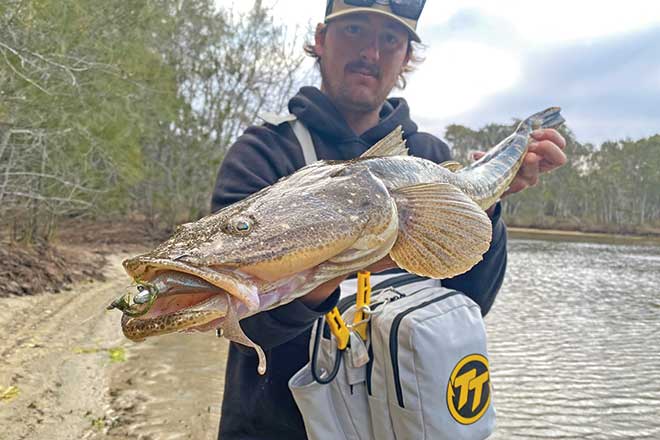Flathead really are the people’s fish as they are readily available, eat a wide variety of bait and lures and the next trophy fish could be caught land-based next to the boat ramp.
In this article I want to look at key areas to target flathead, a few of my favourite soft plastic presentations and a handful of tips to help you catch more fish.
Where to fish
Low tide
Prime times to target flathead are the last two hours of a run-out tide and the first hour of a run-in.
Baitfish and prawns are forced out of the mangroves and off the flats, so key areas to target include channel edges, drop-offs and, in particular, drains that carry the last of the bait off the flats.
Flathead will concentrate in these areas to make the most of the food being brought to them by the falling tide.
If there’s additional structure, such as timber snags and weed edges, or points that create eddies in the current, the fish won’t be far away.
Keep an eye out for active bait because this is another sign that fish are feeding in the area.
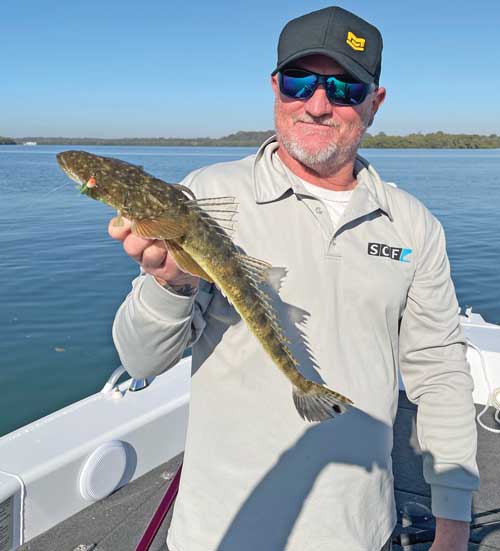
High tide
The last couple of hours of a run-in tide and the first hour of a run-out can also be productive for a high tide.
I tend to target areas that the flathead can’t access on the lower stages of the tide, such as mangrove edges, drains, rock and rubble patches and also manmade structures, such as rock walls, stormwater drains and near high-tide boat ramps.
Flathead will often hold hard up against these edges, patrolling them and feeding on the bait that is looking for shelter, so get your plastics right in against the structure and along the edge of the mangrove root line.
Flathead also love to use shade lines to ambush prey and you will often find them holding under pontoons, jetties, bridges and boat hulls, which also attract bait and in turn predatory species.
Soft plastics are also effective after dark and key places to target include areas with artificial lighting that attracts bait, such as boat ramps, bridges and areas where street lighting floods the water.
Select a soft plastic with a solid colour profile as a strong silhouette and fish the shadow lines created by structure and where the light fades into darkness.
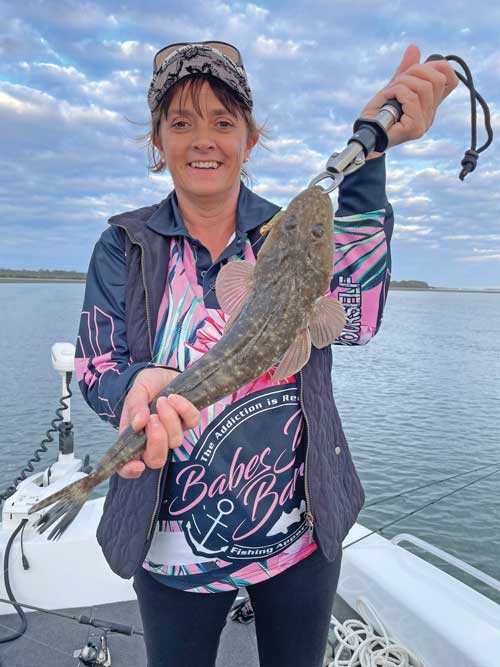
Go-to soft plastic styles
Soft plastics are a go-to for many flathead anglers because they look and feel real, so fish keep biting them.
They are inexpensive, can be fished with a wide variety of retrieves to suit the mood of the fish on the day and the same plastic can be rigged to fish the shallow flats and drains and down to deep edges, channels and structure, based on jig head selection.
The same plastic can also be rigged weedless to fish deep in structure such as timber, weed and mangrove roots, with minimal chance of snagging or fouling.
Let’s look at some popular soft plastic styles in more detail, including how, where and why we might select and fish them.
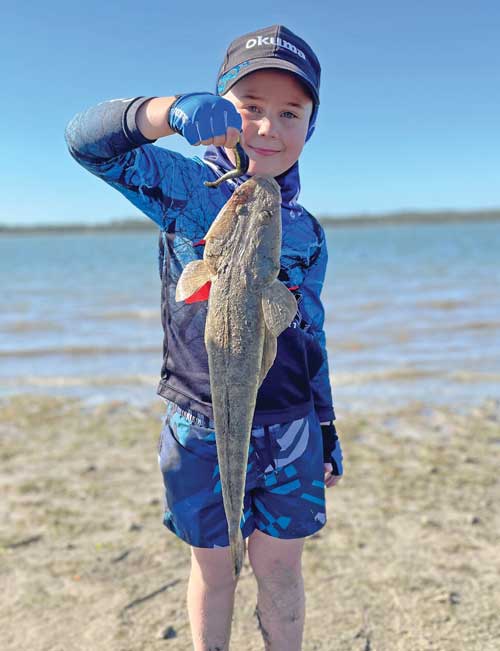
Paddle tails
Without a doubt my favourite presentation for targeting flathead is a paddle tail plastic – much of their diet is made up of small mullet, whiting and other baitfish, with a paddle tail matching the hatch perfectly.
Paddle tails are easy to fish as the tail paddles, making them ‘swim’ on the drop, the retrieve and even when sitting in the current flow, in turn attracting fish and triggering strikes.
On bright days and in clear water, I’ll stick with a natural baitfish colour, such as Opening Night or Bad Shad, switching to fluoro and ultraviolet colours in low light and dirty water conditions, such as Gold Rush, Electric Chicken and Motor Oil.
My go-to paddle tails include a Z-Man2.5” Slim SwimZ (1/0 jig head) if the bait is small, a 3” Slim SwimZ or MinnowZ (3/0 jig head) as a great allrounder for flathead, and a Z-Man 4” DieZel MinnowZ (3/0 or 4/0 jig head) as a larger profile if the bait in the area is bigger.
You can fish a paddle tail almost anywhere on any retrieve, however they are my go-to for slow rolling (slow winding) and twitching over the flats and hopping down drop-offs.
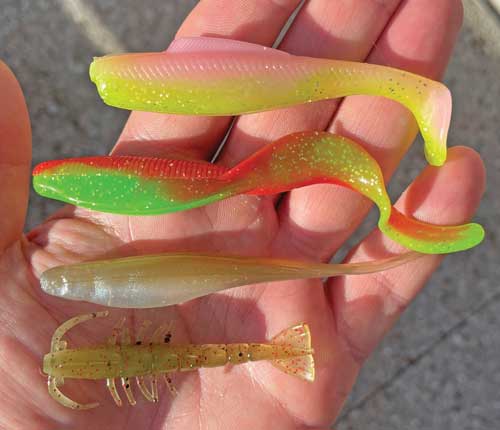
Curl tails
Another favourite that also has loads of built-in action is the curl tail grub.
This plastic is extremely versatile, easy to fish and responds to most retrieves, again making it great for those getting into soft plastics fishing.
Go-to curl tails in my kit for flathead include the Z-Man2.5” GrubZ and ST GrubZ (Size 1 jig head), along with the 4” StreakZ Curly TailZ (3/0 jig head) as a larger profile.
I tend to fish the curl tail plastics in deeper water because they get down quicker and the naturally buoyant Z-Man ElaZtech plastic creates a seductive ‘tail up’ pose when at rest on the bottom, which draws strikes from flathead, snapper, mulloway and more.
This natural attraction is handy when fishing deeper water where contact with the plastic may be reduced.
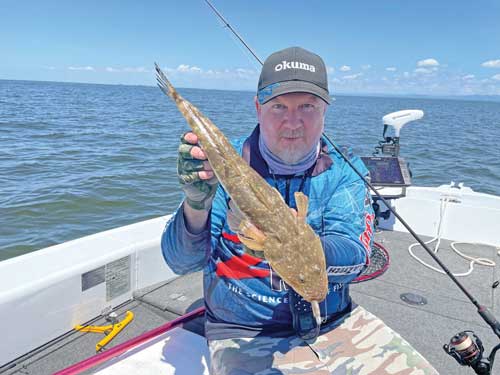
Jerk baits
You will notice that unlike a paddle or curl tails, jerk bait profiles are straight with minimal in-built tail action.
That lack of tail action provides some benefits to anglers.
Less tail action means reduced drag – both through the air and in the water – which is great for casting distance, particularly in windy conditions, and also for allowing the plastic to glide down through the water column quicker and more naturally.
These characteristics make them especially effective when fishing deeper water and stronger currents and have made the jerk bait style of plastic a go-to for offshore anglers.
However, the jerk bait is also deadly on flathead, from flicking it over shallow flats to fishing deeper structure and edges.
Minimal in-built action means that it is up to the angler to impart the action by flicking and twitching the rod tip, so that the jerk bait profile imitates a fleeing or injured baitfish.
A couple of my favourites include the Z-Man 3.75” StreakZ (2/0 jig head) and the 4-5” Scented Jerk ShadZ (4/0-5/0 jig head).
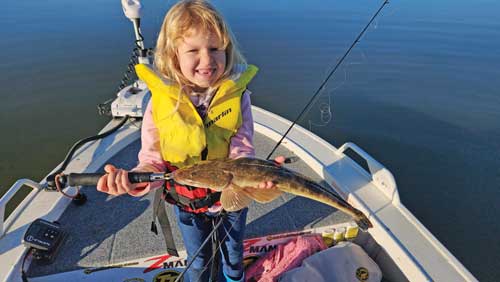
Crustaceans
I will reach for a prawn profile, such as a Z-Man 2.5” PrawnZ (1/0 jig head) or 3.5” EZ ShrimpZ (3/0 jig head), if I’m fishing weed beds, structure and drains that are home to prawns, or if it’s prawn season and they’re running in the rivers and estuaries I’m fishing.
In prawn season, it can be a matter of simply casting these profiles into the areas where the prawns are holding or casting them to prawns that are being harassed and flicking on the surface, which can result in brutal and almost instantaneous strikes.
Remember that prawns tend to move slowly, rather than darting around and swimming larger distances as many baitfish do, so I tend to fish these profiles slower with more hops and twitches and less winding of the reel.
They are especially effective when cast in tight to structure and worked close to that structure.
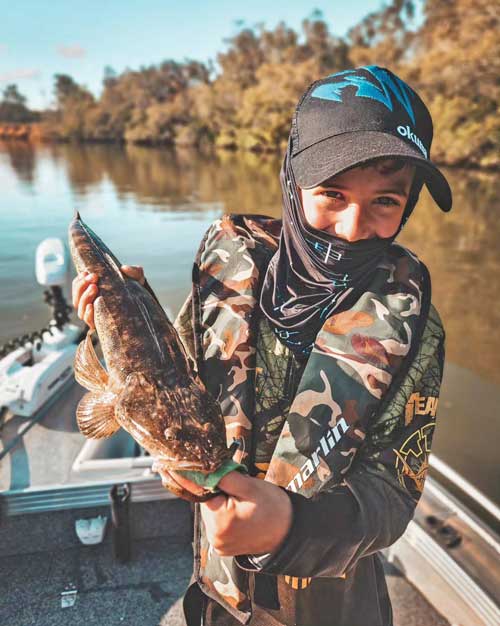
Combo selection
When it comes to rod selection for targeting flathead, a 7’ 2-4kg graphite rod is a great starting point as it allows a long cast and the application of plenty of action.
This is commonly paired with a 2500 size reel and 8-10lb braid for reduced drag, long casts and increased feel, finished with a rod length of 10lb leader to minimise visibility and increase abrasion resistance.
This is a great starting point for anglers, with many adding a 7’ 3-6kg rod to their kit if fishing larger presentations and heavier jig heads as they move into deeper water.
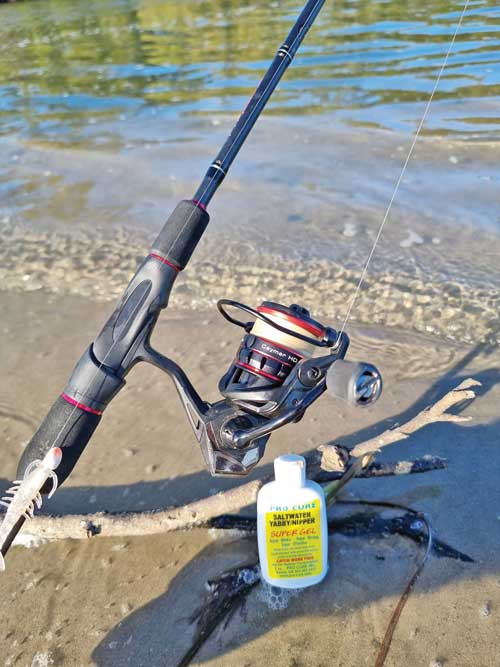
Additional tips
Remember, when handling flathead, they have a spike either side of and on top of their head.
Landing nets and lip grips make landing and handling simpler and safer.
If you don’t have a landing net when fishing land-based, you can use the momentum of the fish and the water it pushes in front of it to slide it up onto the bank.
If you don’t have lip grips, you can hold the flathead securely from underneath by holding firmly on the bony sections between the front and secondary fins, with your thumb on one side and a couple of fingers on the other.
The front fins then protect you from the spikes.
If the water is dirty or the bite is tough, adding scent or a glass rattle to your soft plastic can make a difference.
These are a couple of the one percenters that can make a difference when the fishing is tough, helping experienced anglers to consistently get the bite.
Flathead are a schooling fish, so once you find one, it’s worth making a few more casts in the same area.
If you are catching a bunch of smaller fish (males), it can be worth persisting because they may be schooling around a larger female fish.
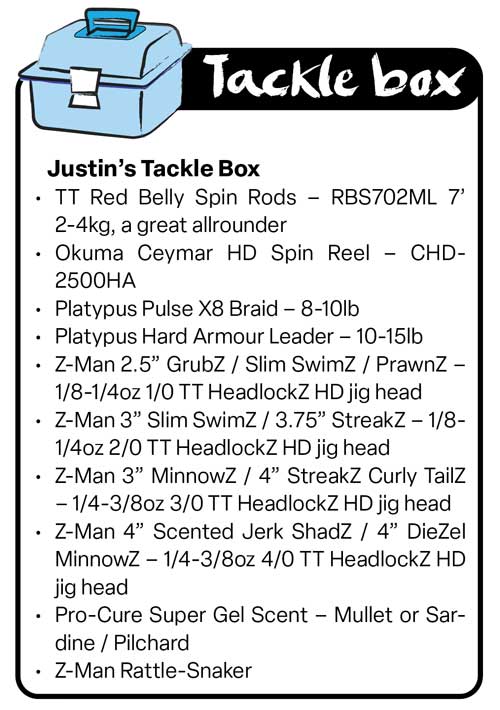
We prefer to return these larger 60cm plus fish to the water as they’ll produce loads of flathead for the future.
Likewise, being a schooling fish, we limit the number of smaller fish we keep, ensuring that there are plenty available to enjoy into the future.
Hopefully these few tips help you to get stuck into your first or a few more flatties on your next adventure.
Remember to think like a fish and breakdown where the fish may be holding and why they might be holding there (structure, current breaks, food), what they may be feeding on (visible bait or the type of bait that resides in that type of area), how that bait moves (your retrieve) and a colour option that suits the conditions you’re fishing in.
Flathead are aggressive, accessible, fun and tasty.
So set yourself up with a basic kit, hit your local river or estuary land based or on the stand-up paddleboard, kayak or boat.
Find the key structure, match the hatch and it won’t be long until you have a bend in the rod.
See you on the water…
 Bush ‘n Beach Fishing Magazine Location reports & tips for fishing, boating, camping, kayaking, 4WDing in Queensland and Northern NSW
Bush ‘n Beach Fishing Magazine Location reports & tips for fishing, boating, camping, kayaking, 4WDing in Queensland and Northern NSW

